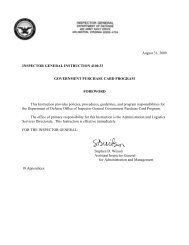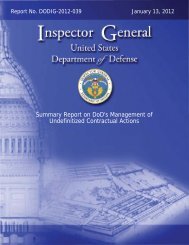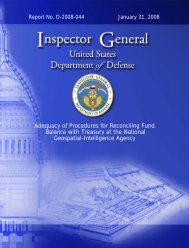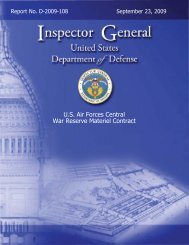Appendix C. Air Force Audit Agency Comments - DoD-IG
Appendix C. Air Force Audit Agency Comments - DoD-IG
Appendix C. Air Force Audit Agency Comments - DoD-IG
Create successful ePaper yourself
Turn your PDF publications into a flip-book with our unique Google optimized e-Paper software.
Oversight Review August 15, 2011<br />
Quality Control Review of<br />
<strong>Air</strong> <strong>Force</strong> <strong>Audit</strong> <strong>Agency</strong>'s<br />
Special Access Program <strong>Audit</strong>s<br />
Report No. D-2011-6-009
Additional Information and Copies<br />
The Department of Defense, Office of the Assistant Inspector General for <strong>Audit</strong> Policy<br />
and Oversight, prepared this report. To obtain additional copies of the final report, visit<br />
www.dodig.mil/audit/reports or contact the Office of the Assistant Inspector General for<br />
<strong>Audit</strong> Policy and Oversight at (703) 604-8760 or fax (703) 604-8982.<br />
Suggestions for Reviews<br />
To suggest or request reviews, contact the Office of the Assistant Inspector General for<br />
<strong>Audit</strong> Policy and Oversight by phone (703) 604-8760 (DSN 664-8760), by fax<br />
(703) 604-8982, or by mail:<br />
OA<strong>IG</strong>-APO<br />
Department of Defense Inspector General<br />
400 Army Navy Drive (Room 833)<br />
Arlington, VA 22202-4704<br />
Acronyms and Abbreviations<br />
AFAA <strong>Air</strong> <strong>Force</strong> <strong>Audit</strong> <strong>Agency</strong><br />
SAP Special Access Programs<br />
GAGAS Generally Accepted Government <strong>Audit</strong>ing Standards
<strong>Appendix</strong> A. <strong>Comments</strong>, Observations, and<br />
Recommendation<br />
We are issuing a pass opinion because we determined that the AFAA quality control<br />
system is adequately designed and functioning as prescribed.<br />
We identified one area of concern related to supervision. We judgmentally tested the<br />
reports for compliance with GAGAS and AFAA audit policies in nine areas to include<br />
independence, professional judgment, competence, audit planning, supervision, evidence,<br />
audit documentation, reporting, and quality control.<br />
Supervision<br />
We identified that for one audit reviewed the working papers did not include an audit<br />
plan showing evidence of supervisory review before the audit had started. In another<br />
audit some working papers did not contain evidence of supervisory review. In addition,<br />
we found that the supervisor did not sign and date all of the audit review records.<br />
GAGAS 7.54 (2007 Revision) requires that reviews of audit work should be documented.<br />
The nature and extent of the review of audit work may vary depending on a number of<br />
factors, such as the size the audit organization, the significance of the work, and the<br />
experience of the staff.<br />
<strong>Air</strong> <strong>Force</strong> <strong>Audit</strong> <strong>Agency</strong> Instruction, 65-101, Financial Management, Installation Level<br />
<strong>Audit</strong> dated November 19, 2010, Section 2.8 states that the auditor must prepare a written<br />
audit program before starting any in-depth audit work. Team chiefs will review the<br />
program for adequacy and approve the program before the auditor starts audit testing.<br />
<strong>Air</strong> <strong>Force</strong> <strong>Audit</strong> <strong>Agency</strong> Instruction 65-103, <strong>Audit</strong> Management and Administration,<br />
dated April 6, 2006, Section 6.2.3 states that whether accomplished electronically or<br />
manually, the <strong>Audit</strong> Review Record must include the supervisor’s initials and date, and<br />
the working papers must contain clear evidence of supervisory review.<br />
Although we identified lack of documentation of supervisory review, we found support<br />
that the supervisor was generally kept informed of the audit status through biweekly<br />
status reports and through quarterly site visits to audit staff locations to perform audit<br />
reviews.<br />
Recommendation: We recommend that the AFAA Representative for Special Programs<br />
follow <strong>Air</strong> <strong>Force</strong> <strong>Audit</strong> <strong>Agency</strong> instructions relating to audit supervision to include that<br />
<strong>Air</strong> <strong>Force</strong> <strong>Audit</strong> <strong>Agency</strong> audit review records are reviewed, initialed, and dated and audit<br />
documentation includes an approved audit program.<br />
1
Management <strong>Comments</strong>: AFAA Acting Director of Operations concurred with the<br />
recommendation and stated that the AFAA Representative for Special Programs will<br />
follow AFAA instructions relating to audit supervision and ensure all working papers and<br />
AFAA audit review records are reviewed and initialed. Also, the AFAA Representative<br />
will verify project files include an approved audit program during supervisory reviews.<br />
Reviewer Response: Management comments are responsive.<br />
2
<strong>Appendix</strong> B. Scope and Methodology<br />
We limited our review to the adequacy of AFAA SAP audits’ compliance with quality<br />
policies, procedures, and standards. We judgmentally selected two SAP audits from a<br />
universe of eleven SAP audit reports issued by AFAA SAP auditors during FY 2009 and<br />
FY 2010. We tested each audit for compliance with the AFAA system of quality control.<br />
The Army <strong>Audit</strong> <strong>Agency</strong> conducted a review of the AFAA internal quality control<br />
system for non-SAP audits and/or attestation engagements and will issue a separate<br />
report. The Deputy Inspector General for Policy and Oversight will issue an overall<br />
opinion report on the AFAA internal quality control system that will include the<br />
combined results of the SAP and non-SAP audit reviews.<br />
In performing our review, we considered the requirements of quality control standards<br />
contained in the 2007 Revision of GAGAS issued by the Comptroller General of the<br />
United States. GAGAS 3.56 states:<br />
The audit organization should obtain an external peer review sufficient<br />
in scope to provide a reasonable basis for determining whether the audit<br />
organization is complying with its quality control system in order to<br />
provide the audit organization with reasonable assurance of conforming<br />
with applicable professional standards.<br />
We conducted this review in accordance with standards and guidelines established in the<br />
March 2009 Council of the Inspectors Generals on Integrity and Efficiency “Guide for<br />
Conducting External Peer Reviews of <strong>Audit</strong> Organizations of the Federal Offices of<br />
Inspector General,” and the Quality Standards for Inspection and Evaluation. The Army<br />
<strong>Audit</strong> <strong>Agency</strong> used this guide in review of non-SAP audits at the AFAA. We reviewed<br />
audit documentation, interviewed AFAA auditors, and reviewed AFAA internal audit<br />
policies. We reviewed the <strong>DoD</strong> O<strong>IG</strong> Report No. D-2008-6-007, “Quality Control<br />
Review of the <strong>Air</strong> <strong>Force</strong> <strong>Audit</strong> <strong>Agency</strong>’s Special Access Program <strong>Audit</strong>s” dated<br />
August 15, 2008. We performed this review from April to June 2011 at two AFAA<br />
offices.<br />
We used the following criteria to select the audits under review:<br />
� Worked backward starting with the FY 2010 audits in order to review the<br />
most current quality assurance procedure in place.<br />
� Avoided audits with multiple SAPs associated with the audit for ease of<br />
access.<br />
� Avoided audits that have the same or similar titles to ensure review of<br />
multiple types of projects.<br />
3
Limitations of Review. Our review would not necessarily disclose all weaknesses in the<br />
system of quality control or all instances of noncompliance with it because we based our<br />
review on selective tests. There are inherent limitations in considering the potential<br />
effectiveness of any quality control system. In performing most control procedures,<br />
departures can result from misunderstanding of instructions, mistakes of judgment,<br />
carelessness, or other human factors. Projecting any evaluation of a quality control<br />
system into the future is subject to the risk that one or more procedures may become<br />
inadequate because conditions may change or the degree of compliance with procedures<br />
may deteriorate.<br />
4
<strong>Appendix</strong> C. <strong>Air</strong> <strong>Force</strong> <strong>Audit</strong> <strong>Agency</strong> <strong>Comments</strong><br />
5



